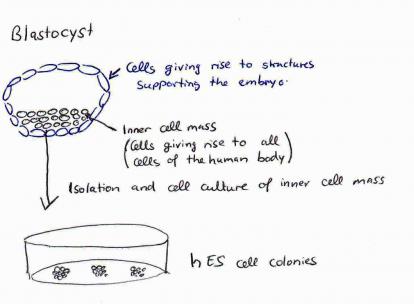Wrap your mind around neural stem cells
Why am I writing this blog? I work with stem cells and noticed that often people who are not part of the scientific community are not aware what that means, but mentioning it gives them an awkward feeling. So my aim is to explain briefly and hopefully clearly, what we do in our lab and why I think it is worthwhile doing it.

Since this is a lot to cover I will split it:
- This time the topic will be neural stem cells, the cell system we are working with.
- Next time I will explain what microRNAs are.
- In my third article I want to show you how we combine these tools in our experiments.
What are neural stem cells? They are the precursors of the cells that make up the human brain. It is kind of self-explanatory that it is not easy to find humans who want to donate these cells. So we need other sources. For this reason a technique was established in our lab to generate neural stem cells from starter cells that have the potential to become every cell of the human body – the famous human embryonic stem cells (hES). But how do you generate these starter cells in the first place? To explain this, I drew this little scheme:
In early human development there is a stage (5 days after fertilization) that is called the blastocyst. It has an outer layer of cells that generate the external structures around the embryo and an inner cell mass that is the material that gives rise to all the cells of the embryo itself. This inner cell mass is isolated and brought into cell culture. These cells are the hES cells. Unfortunately this destroys the blastocyst and leaves us with an ethical dilemma that has been the subject of much discussion. The source of these cells may be disputable, but there are existing cell lines that are capable of almost unlimited expansion – in other words, cells in culture that can go on making more cells almost forever. The generation of new human embryonic cell lines is forbidden in Germany but the importation of cell lines generated before a certain cut-off date is allowed - though restricted to important projects.
In the last few years, an alternative to hES cells has been found. The new holy grail of stem cell biology: induced pluripotent stem cells – short iPS.
I drew you a short simplified scheme to show how this works:

These cells seem to resemble the characteristics of hES cells – like their ability to become every cell of the human body and their almost unlimited capacity to make more cells – but can be generated from tissue samples an adult person donates. Nevertheless, since this method is very new, iPS cells still need to be tested for their quality compared to the gold standard hES cells. So it seems that we still need hES cells for the next years.
In our lab hES as well as iPS cells are used to derive neural stem cells:

The goal is to use these stem cells as a stable, expandable culture of cells that can generate neurons on demand. Neural stem cells that are derived from iPS cells will have the same genes as the donor we got the source cells from. In the case of cells donated by a patient suffering from a genetic disease, we are able to generate a cell model of the disease – cells carrying the same genetic defect as the patient’s cells.
This will enable us to test potential new therapeutic drugs on human cells (for example neurons) that are really affected by diseases (like Parkinson's), instead of using artificial disease models such as genetically altered animals.